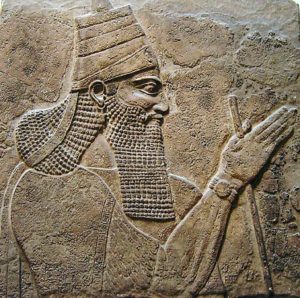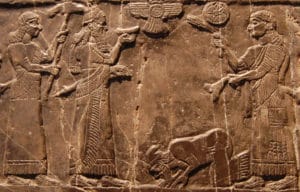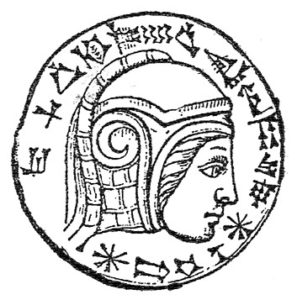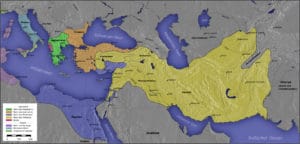
The Arabs and the Chaldeans are first mentioned in written history (circa 850 BC) in the annals of Shalmaneser III.
It was during this period that an Akkadian influenced form of Eastern Aramaic was adopted by the Assyrians as the lingua franca of their vast empire, and Mesopotamian Aramaic began to supplant Akkadian as the spoken language of the general populace of both Assyria and Babylonia. The descendant dialects of this tongue survive amongst the Mandaeans of southern Iraq and Assyrians of northern Iraq to this day.

In the late 7th century BC, the Assyrian Empire tore itself apart with a series of brutal civil wars, weakening itself to such a degree that a coalition of its former subjects; the Babylonians, Chaldeans, Medes, Persians, Parthians, Scythians and Cimmerians, were able to attack Assyria, finally bringing its empire down by 605 BC.
Babylonian and Persian Periods:
The short-lived Neo-Babylonian Empire (620–539 BC) succeeded that of Assyria. It failed to attain the size, power or longevity of its predecessor; however, it came to dominate The Levant, Canaan, Arabia, Israel and Judah, and to defeat Egypt. Initially, Babylon was ruled by yet another foreign dynasty, that of the Chaldeans, who had migrated to the region in the late 10th or early 9th century BC. Its greatest king, Nebuchadnezzar II, rivalled another non native ruler, the ethnically unrelated Amorite king Hammurabi, as the greatest king of Babylon. However, by 556 BC, the Chaldeans had been deposed from power by the Assyrian born Nabonidus and his son and regent Belshazzar.

In the 6th century BC, Cyrus the Great of neighbouring Persia defeated the Neo-Babylonian Empire at the Battle of Opis and Iraq was subsumed into the Achaemenid Empire for nearly two centuries. The Achaemenids made Babylon their main capital. The Chaldeans and Chaldea disappeared at around this time, though both Assyria and Babylonia endured and thrived under Achaemenid rule. Little changed under the Persians, having spent three centuries under Assyrian rule, their kings saw themselves as successors to Ashurbanipal, and they retained Assyrian Imperial Aramaic as the language of empire, together with the Assyrian imperial infrastructure, and an Assyrian style of art and architecture.
In the late 4th century BC, Alexander the Great conquered the region, putting it under Hellenistic Seleucid rule for over two centuries. The Seleucids introduced the Indo-Anatolian and Greek term Syria to the region. This name had for many centuries been the Indo-European word for Assyria and specifically and only meant Assyria; however, the Seleucids also applied it to The Levant.

The Parthians (247 BC – 224 AD) from Persia conquered the region during the reign of Mithridates I of Parthia (r. 171–138 BC). From Syria, the Romans invaded western parts of the region several times, briefly founding Assyria Provincia in Assyria. Christianity began to take hold in Iraq (particularly in Assyria) between the 1st and 3rd centuries, and Assyria became a center of Syriac Christianity, the Church of the East and Syriac literature. A number of independent states evolved in the north during the Parthian era, such as Adiabene, Assur, Osroene and Hatra.
